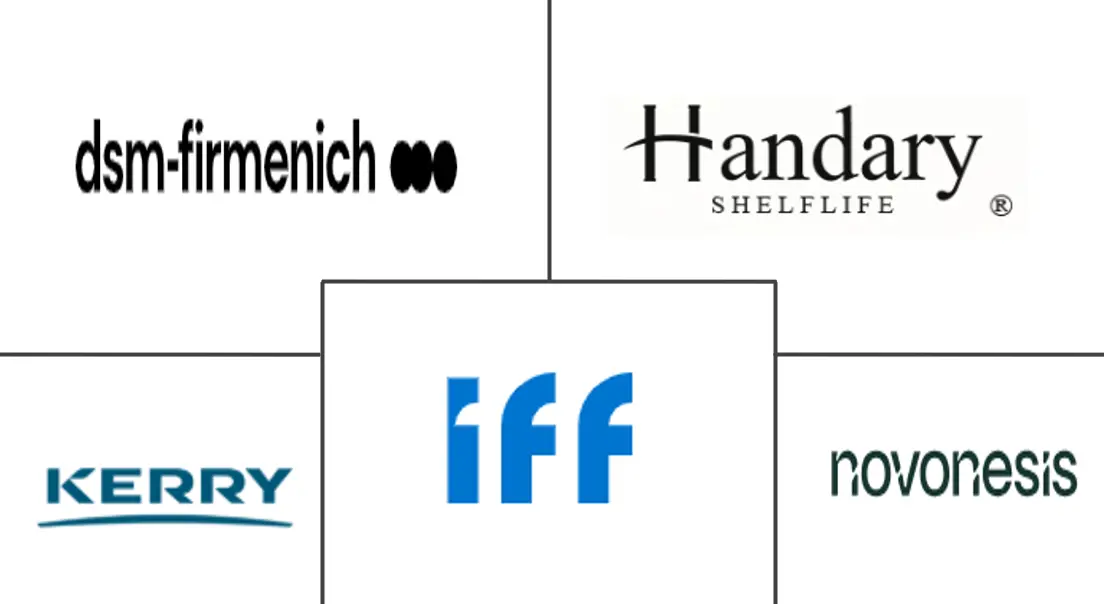Food Antimicrobial Additives Market Size and Share
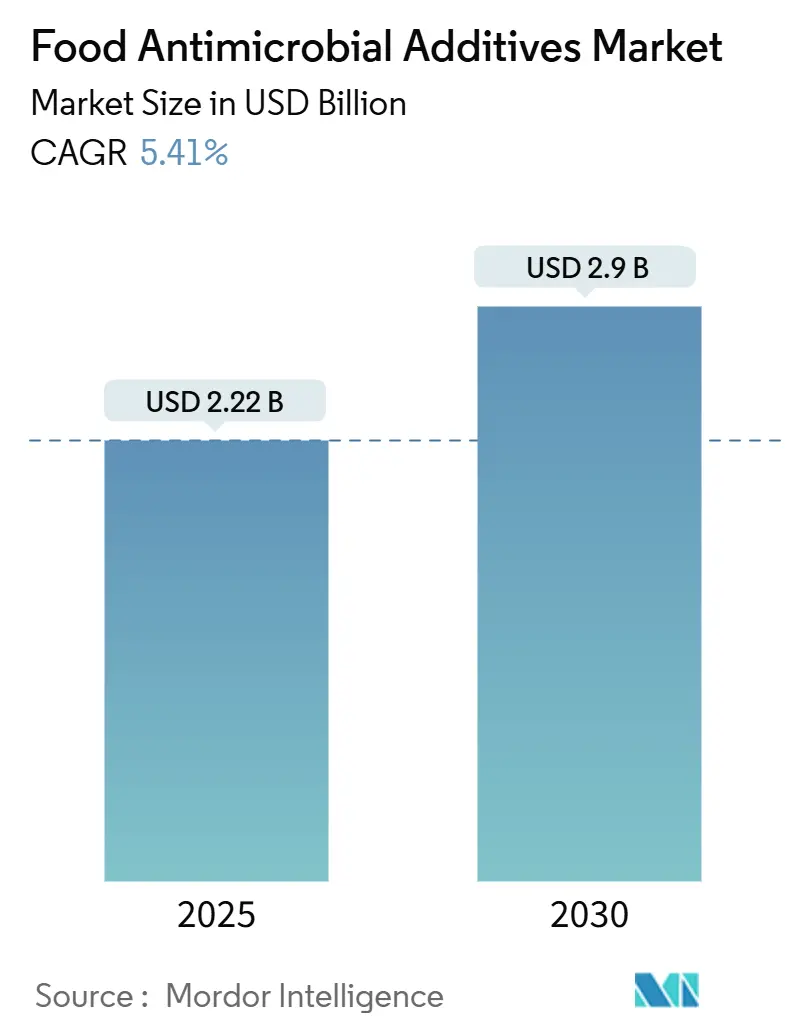
Food Antimicrobial Additives Market Analysis by Mordor Intelligence
The food antimicrobial additives market generated USD 2.22 billion in 2025 and is forecast to reach USD 2.90 billion by 2030, advancing at a 5.41% CAGR. Driven by technological advancements in preservation and a heightened demand for safety during extended distribution cycles, the food antimicrobial additives market is witnessing consistent growth. While synthetic variants currently hold the majority share, natural alternatives are rapidly gaining traction. This shift is largely attributed to the clean-label trend and innovations such as bacteriocin systems and fermentation-derived extracts, which have enhanced the efficacy of these natural options. Powdered forms dominate the market, prized for their formulation flexibility and scalability. Meat and meat products are the primary applications, yet emerging segments are quickly catching up. North America stands as the largest market, but the most pronounced growth is anticipated in the Middle East and Africa. Regulatory pressures are pushing manufacturers towards more stringent antimicrobial practices and hastening the approval of novel compounds. Moreover, encapsulation technologies not only bolster functional performance but also safeguard sensory qualities, paving the way for cost-effective products that resonate with consumers. Collectively, these trends set the stage for a sustainable and innovation-led market expansion.
Key Report Takeaways
- By product type, the synthetic antimicrobials segment held 80.17% of the food antimicrobials additives market share in 2024, while the natural segment is advancing at a 7.09% CAGR through 2030.
- By form, the powder segment accounted for 49.47% of the food antimicrobials additives market size in 2024 and is expanding at a 6.88% CAGR from 2025-2030.
- By application, meat and meat products led with 20.02% revenue share in 2024; the beverages segment posts the fastest growth at 5.99% CAGR.
- By geography, North America commanded 29.52% share of the food antimicrobials additives market in 2024, whereas the Middle East and Africa region records the highest projected CAGR of 7.04% to 2030.
Global Food Antimicrobial Additives Market Trends and Insights
Drivers Impact Analysis
| Driver | (~) % Impact on CAGR Forecast | Geographic Relevance | Impact Timeline |
|---|---|---|---|
| Growing demand in meat processing sector | +1.2% | Global, with concentration in North America and Asia-Pacific | Medium term (2-4 years) |
| Increased awareness of foodborne illnesses among consumer | +0.9% | Global, particularly developed markets | Short term (≤ 2 years) |
| Rising adoption in plant-based food and dairy alternatives | +0.7% | North America and Europe, expanding to Asia-Pacific | Medium term (2-4 years) |
| Increasing demand for minimal processing techniques | +0.6% | Global, led by premium segments | Long term (≥ 4 years) |
| Innovation in active packaging technology | +0.5% | Developed markets, spill-over to emerging economies | Long term (≥ 4 years) |
| Surging demand for food product with extended shelf life | +0.8% | Global, accelerated in e-commerce channels | Short term (≤ 2 years) |
| Source: Mordor Intelligence | |||
Growing Demand in Meat Processing Sector
The demand for antimicrobial additives in the meat processing industry is rising, driven by increasing global consumption of processed and ready-to-eat meat products. Consumers now seek safer, high-quality, and clean-label meat options, prompting the adoption of advanced antimicrobial preservation technologies. North America—particularly the U.S. and Mexico—continues to lead this trend due to high per capita meat consumption and a mature processing infrastructure. According to USDA projections, U.S. per capita meat consumption is expected to reach 82.5 kg by 2033, with poultry rising from 38.3 kg in 2023 to 43.8 kg, pork at 22.6 kg, and beef at 16.0 kg. In 2024 alone, poultry consumption rose 1% to 4.94 million metric tons, pork by 3% to 2.7 million metric tons, and beef by 3% to 2.2 million metric tons [1]U.S. Department of Agriculture, "Meat Consumption in Mexico, Led by Poultry, Will Continue Rising Over Next Decade, USDA Projections Show," usda.gov. Regulatory measures, such as the USDA’s updated antimicrobial protocols for poultry aimed at reducing Salmonella, are also propelling demand for more effective and natural solutions. Key suppliers have responded with tailored innovations: Corbion’s Purac line offers lactic acid and vinegar-based systems for processed meats; Kerry Group’s clean-label antimicrobials like PreservR and Provian K use vinegar and fermented ingredients; and Kemin’s BactoCEASE® line applies buffered vinegar and plant extracts for sausage preservation.
Increased Awareness of Foodborne Illnesses Among Consumer
Consumer awareness of foodborne pathogens has reached unprecedented levels, driven by high-profile contamination incidents and enhanced food safety communication. This heightened awareness influences purchasing decisions, with consumers preferring products that incorporate proven antimicrobial protection, especially in ready-to-eat foods where contamination risks are higher. Natural antimicrobial additives, including nisin and natamycin, have gained prominence in ready-to-eat meat and cheese products as they effectively inhibit spoilage and pathogenic microorganisms while supporting clean-label claims. While the United States food supply maintains high safety standards, concerns about emerging pathogens and antibiotic resistance drive continuous industry monitoring. Modern preservation technologies implement a multiple-hurdle approach by combining traditional antimicrobials with newer compounds. These include organic acid derivatives, such as lactates and sorbates, along with plant-derived extracts from citrus and rosemary that provide effective antimicrobial protection while meeting consumer safety preferences.
Rising Adoption in Plant-Based Food and Dairy Alternatives
The growth of plant-based food and dairy alternatives presents both opportunities and challenges in the antimicrobial additives market. These products require enhanced preservation methods across retail distribution and cold chains to maintain safety and shelf stability. Plant-based formulations are particularly susceptible to microbial spoilage due to their natural sugar content, high moisture levels, and limited synthetic preservatives. This has increased the demand for natural and clean-label antimicrobial additives, including plant extracts, organic acids, and fermentation-based ingredients that address both preservation requirements and consumer preferences for transparency and sustainability. Consumer adoption data demonstrates the market's significance. In the United States, 53% of consumers have consumed plant-based meat products, with 24% consuming them at least monthly as regular or occasional users as of 2024 [2]Source: The Good Food Institute, “Plant-Based Meat in the U.S.,” The Good Food Institute, gfi.org. This consumer base requires manufacturers to increase production while maintaining extended shelf life without compromising clean-label standards. Dairy alternatives, including oat milk, almond milk, and vegan cheese products, show substantial market growth but need precise microbial control for safety and stability during distribution. Plant-based meat alternatives, produced from legumes, grains, and oils, require significant antimicrobial protection as they lack the natural preservation mechanisms found in animal-based products.
Increasing Demand for Minimal Processing Techniques
Advanced processing technologies are transforming antimicrobial applications in food preservation, responding to consumer demand for nutritious and safe products. High-temperature short-time and ultra-high-temperature processing methods enhance microbial control while maintaining bioactive compounds more effectively than conventional pasteurization. Non-thermal preservation techniques, including cold plasma, pulsed electric fields, and ultrasound treatments, provide antimicrobial protection without compromising heat-sensitive nutrients. Improved encapsulation methods for natural antimicrobials, particularly nisin delivery systems with emulsion-based carriers, increase preservation effectiveness while supporting minimal processing goals. Consumer preferences significantly influence this transition. The International Food Information Council (IFIC) reports that in 2024, 79% of U.S. adults evaluated food and beverage processing levels before purchasing, linking ultra-processed foods to health concerns, including specific cancers, cardiovascular disease, and type 2 diabetes [3]Source: International Food Information Council, “2024 IFIC Food & Health Survey,” Food Insight, foodinsight.org. These consumer preferences drive market demand for products that retain fresh characteristics and nutritional value while ensuring microbiological safety.
Restraints Impact Analysis
| Restraint | (~) % Impact on CAGR Forecast | Geographic Relevance | Impact Timeline |
|---|---|---|---|
| Stringent regulatory approvals | -0.8% | Global, particularly stringent in Europe and North America | Long term (≥ 4 years) |
| Unpleasant taste or odour from some antimicrobials | -0.6% | Global, consumer-driven markets | Medium term (2-4 years) |
| Negative impact on product texture and color | -0.4% | Global, premium product segments | Medium term (2-4 years) |
| Compatibility issues with food matrices | -0.5% | Global, complex formulation markets | Long term (≥ 4 years) |
| Source: Mordor Intelligence | |||
Stringent Regulatory Approvals
The regulatory approval processes for new antimicrobial compounds present significant market entry barriers. Recent regulatory changes have increased these challenges. The European Commission's Regulation (EU) 2024/2597, which updates specifications for sorbic acid and potassium sorbate, requires extensive documentation and includes transitional compliance periods. The FDA has established stricter guidelines for Generally Recognized as Safe (GRAS) determinations and increased post-market surveillance requirements, raising compliance costs for manufacturers. Similarly, Canada's amendments to food additive regulations through SOR/2024-244 have created immediate compliance challenges that affect product launch timelines. The requirements for toxicological studies and environmental impact assessments particularly impact natural antimicrobial compounds, as existing regulatory frameworks, designed for synthetic chemicals, may not effectively address new preservation mechanisms.
Unpleasant Taste or Odour From Some Antimicrobials
Sensory challenges hinder the adoption of antimicrobial additives in food products. Certain compounds can adversely affect flavor, aroma, or texture. For example, sodium benzoate grapples with safety and sensory issues, especially in beverages. This is due to its sharp taste and its potential to form benzene when mixed with vitamin C, a known health concern. While essential oil-based antimicrobials excel at controlling pathogens, their pronounced flavors necessitate expensive encapsulation technologies to mask undesirable notes, which in turn limits scalability and increases production costs. However, emulsion-based carriers for compounds like nisin have proven effective, allowing seamless integration into food matrices without sacrificing taste or quality. These carriers enhance the stability and functionality of antimicrobials, making them more adaptable for various food applications. Consequently, the industry is pivoting towards fermentation-derived antimicrobials. These not only offer natural preservation but also ensure minimal sensory disruption, aligning with both clean-label and functional product aspirations. Fermentation-derived antimicrobials are gaining traction due to their ability to meet consumer demand for natural and sustainable food preservation solutions while maintaining product integrity.
Segment Analysis
By Product Type: Natural Alternatives Gain Momentum
Natural antimicrobials are experiencing market growth at 7.09% CAGR through 2030, while synthetic compounds maintain 80.17% market share in 2024. Nisin shows significant potential in dairy preservation, as its nanoparticle formulations effectively eliminate methicillin-resistant Staphylococcus aureus and E. coli O157:H7 in yogurt without affecting sensory qualities. Vinegar-based preservation systems are increasing in clean-label formulations, utilizing acetic acid's antimicrobial properties to meet consumer demand for familiar ingredients and natural solutions.
Synthetic antimicrobials continue to lead the market due to proven effectiveness and lower costs across multiple applications. Benzoates represent the largest synthetic category, primarily due to their widespread use in beverages and food products. Sorbates show steady growth in bakery applications, with regulations permitting up to 1,000 mg/kg in bakery products for shelf life extension and preservation. Propionates are increasingly used in grain-based products, while lactates and acetates grow in meat processing, where pH control enhances preservation effectiveness. While synthetic compounds will maintain market dominance through 2030, natural alternatives' higher growth rates indicate a gradual shift in market dynamics as their production costs decrease and efficiency improves.
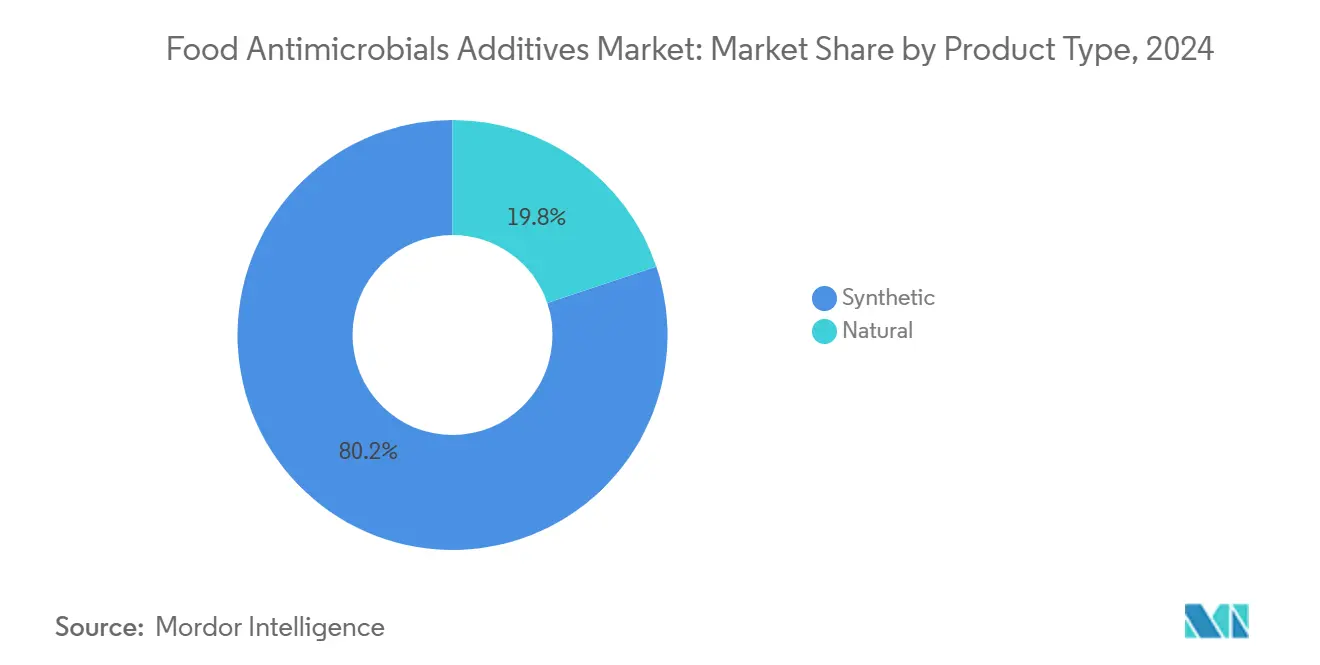
By Form: Powder Dominance Reflects Handling Advantages
In 2024, powder formulations dominated the food antimicrobial additives market, capturing 49.47% of the total share. Their edge comes from superior handling, flexible formulation, and enhanced storage stability. Powders like nisin and natamycin, commonly used in processed cheese, baked goods, and cured meats, seamlessly blend with dry ingredients without losing their antimicrobial punch. Encapsulated powder systems allow for a controlled release of volatile compounds, minimizing sensory effects. With technological strides like spray-drying and nanotechnology integration, powders are set to maintain their lead, boasting a projected CAGR of 6.88% through 2030.
Liquid formulations, despite a smaller market share, are witnessing robust growth in high-moisture applications such as beverages, salad dressings, fresh-cut fruits, and dairy. Formulations like lauric arginate (LAE), propionates, and citrus extract blends ensure rapid dissolution and even distribution, achieving effective microbial control. While they lack the storage stability of powders, their suitability for immediate-use applications fuels demand. As these liquids carve out a niche in specialized formulations, their contribution to the market continues to rise.
By Application: Meat Products Lead Amid Diversification
In 2024, meat and meat products command the largest market share at 20.02%. This dominance is largely due to stringent pathogen control requirements and regulatory mandates, especially those aimed at reducing Salmonella in poultry processing. Such regulations are catalyzing the adoption of advanced antimicrobial systems, underscoring the industry's commitment to food safety and compliance. Meanwhile, the beverages segment is emerging as the fastest-growing category, boasting a CAGR of 5.99%. The rising allure of plant-based alternatives and functional beverages fuels this surge. Moreover, there's a pronounced demand for clean-label ingredients and products with an extended shelf life. This trend is driving the increased utilization of natural and bio-based antimicrobials. In the bakery and confectionery realm, specialized antimicrobial systems are pivotal for achieving an extended shelf life, especially in low-moisture settings.
Dairy product preservation is increasingly turning to natural antimicrobial solutions, notably lactic acid bacteria fermentates. These solutions not only prolong shelf life but also resonate with the burgeoning consumer inclination towards probiotic and functional dairy products. The snacks and savory foods segment is reaping the rewards of innovations tailored to its myriad product formats and packaging styles. Techniques like surface-applied antimicrobials and modified atmosphere packaging (MAP) are bolstering shelf stability, all while catering to demands for convenience and freshness. A consistent theme across all food categories is the alignment of food safety protocols with the surging consumer appetite for natural, label-friendly ingredients. This alignment is a significant catalyst for the growth of antimicrobial applications, ensuring product quality, regulatory adherence, and alignment with evolving consumer expectations centered on safety, functionality, and clean-label attributes.
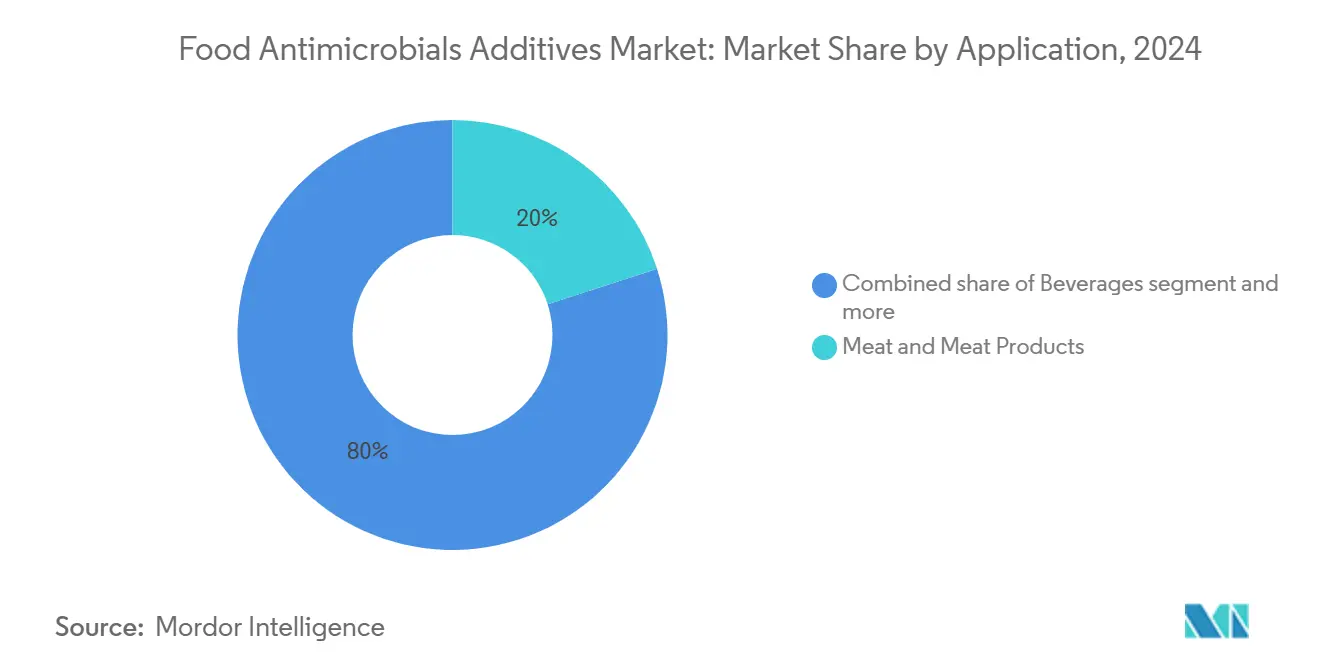
Note: Segment shares of all individual segments will be available upon report purchase
Geography Analysis
In 2024, North America commands a dominant 29.52% share of the food antimicrobial additives market, bolstered by stringent regulatory oversight and a well-established food processing infrastructure. The region's mature supply chains, coupled with technical expertise, have led to the proactive adoption of advanced preservation technologies, including encapsulated antimicrobials. This has facilitated their integration across a wide array of food categories. Furthermore, as consumers increasingly demand clean-label and minimally processed products, manufacturers are gravitating towards natural antimicrobial solutions that align with safety and regulatory benchmarks.
The Middle East and Africa (MEA) region is on a rapid ascent, boasting the industry's fastest growth rate with a projected CAGR of 7.04% through 2030. This expansion is fueled by enhancements in food processing capabilities, a heightened awareness of food safety, and a rising consumer inclination towards clean-label, plant-based offerings. Additionally, government investments in food security and infrastructure, paired with breakthroughs in nano-encapsulation technologies, are paving the way for the broader and more effective use of antimicrobial additives across diverse food products.
Europe and Asia-Pacific present a tapestry of growth dynamics. Europe solidifies its market stance through rigorous regulations, pioneering food safety innovations, and a sustainability-centric approach that champions natural antimicrobials and eco-friendly packaging. In contrast, Asia-Pacific's growth narrative is multifaceted: while established economies like Japan and Australia are at the forefront, embracing cutting-edge antimicrobial technologies, burgeoning markets such as India and China are laying the groundwork with essential food safety enhancements. This intricate regional interplay not only influences the global trajectory of antimicrobial adoption but also underscores the significant contributions of both regions to innovation and consumption.
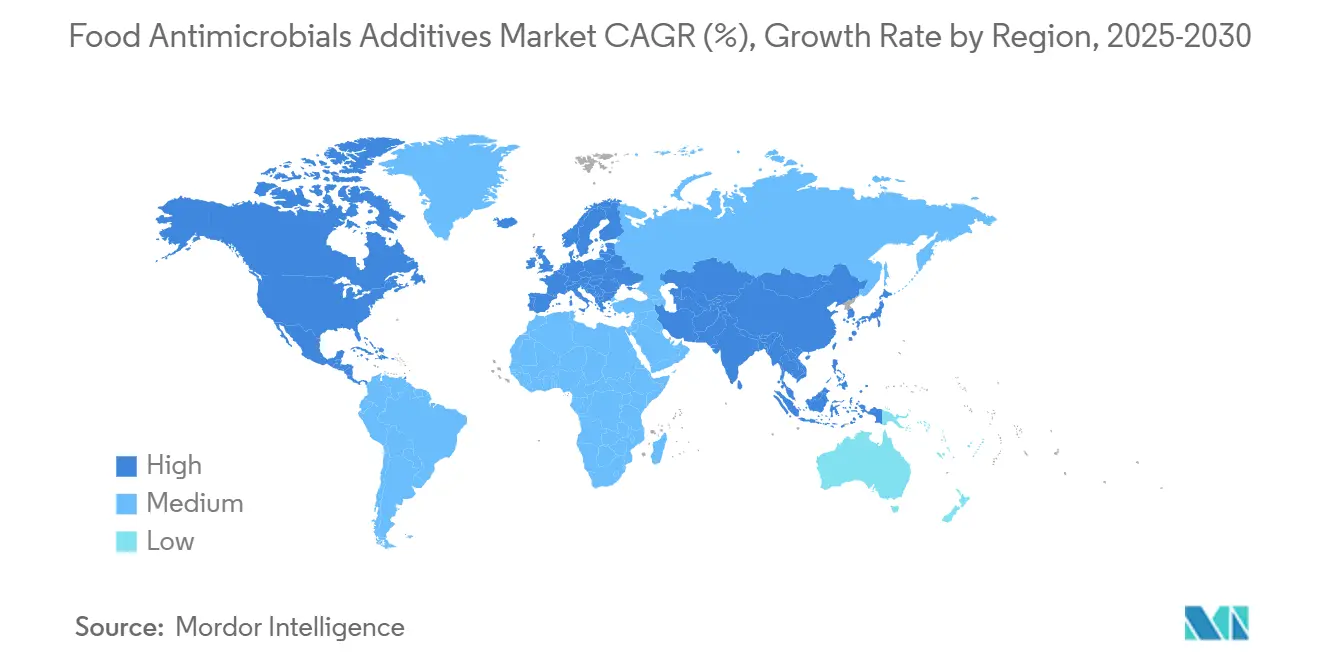
Competitive Landscape
The food antimicrobial additives market is moderately fragmented, yet key players hold a concentrated presence. This dynamic allows both multinational corporations and niche ingredient suppliers to vie for dominance, often through technical differentiation and expertise in specific applications. Leading the charge are market giants like International Flavors & Fragrances Inc., DSM-Firmenich AG, Novonesis (formerly Chr. Hansen Holding A/S), Kerry Group plc, and Handary S.A. These players harness vertical integration, melding raw material sourcing with specialized processing. This strategy not only optimizes costs but also ensures consistent quality across a spectrum of antimicrobial compounds.
Companies are ramping up investments in encapsulation technologies and controlled-release systems. These advancements aim to bolster antimicrobial efficacy while minimizing any adverse effects on taste or texture. For instance, Kerry Group’s innovative approach with microencapsulated vinegar blends. Their work has notably extended the shelf life of clean-label meat products, all the while curbing off-flavors and enhancing sensory appeal.
As the industry evolves, fresh growth opportunities are surfacing in areas like plant-based food preservation and active packaging systems. Here, traditional antimicrobial methods are being tailored to fit new food matrices, driven by a surge in consumer demand for sustainable and eco-friendly packaging. To stay ahead in this competitive landscape, companies are adopting a two-pronged strategy. They're broadening their synthetic antimicrobial offerings to cater to industrial demands, all the while channeling investments into natural alternatives. This dual approach aligns seamlessly with the industry's pivot towards clean-label and minimally processed foods.
Food Antimicrobial Additives Industry Leaders
-
International Flavors & Fragrances Inc.
-
DSM-firmenich AG
-
Kerry Group plc
-
Handary S.A.
-
Novonesis (Chr. Hansen Holding A/S)
- *Disclaimer: Major Players sorted in no particular order
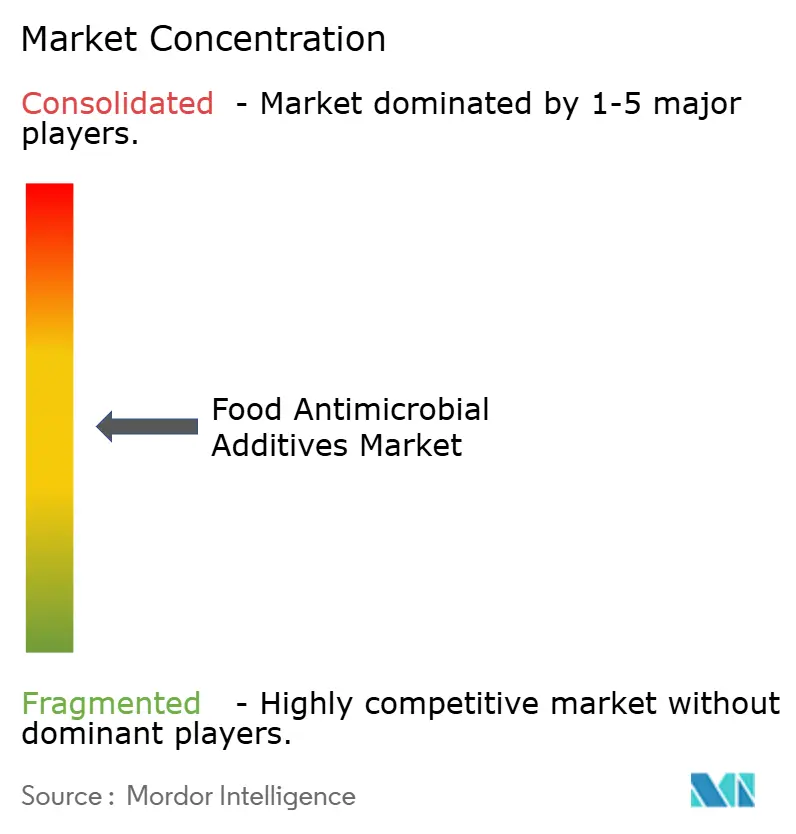
Recent Industry Developments
- June 2025: DSM‑Firmenich broke ground on a cutting-edge production facility in Parma, Italy, marking a significant investment in its Taste, Texture, and Health division. The plant, scheduled for completion by Q1 2027, will enhance the company’s global capabilities in concentrated powder flavors, reaction flavors, culinary blends, and functional blends.
- December 2023: Corbion announced the mechanical completion of its new circular lactic acid manufacturing plant in Rayong, Thailand, a first-of-its-kind facility designed to produce lactic acid with the lowest carbon footprint in the industry. The innovative process eliminates the use of lime and avoids gypsum by-product formation, significantly improving sustainability and cost-efficiency. With all critical mechanical systems now in place, the plant has entered its commissioning phase, with startup expected shortly after Q1 2024.
- May 2023: Florida Food Products launched VegStable Secure, a clean-label antimicrobial ingredient. The ingredient enables brands to naturally protect a variety of foods from pathogens and spoilage by reducing the growth of Listeria monocytogenes. VegStable Secure targets the Listeria monocytogenes and spoilage bacteria that are found in food. The product also may extend the shelf life of multiple applications like meats, hams, and hot dogs while doing so naturally through plants.
Research Methodology Framework and Report Scope
Market Definitions and Key Coverage
Our study defines the food antimicrobial additives market as the global value of chemical or bio-based compounds that are intentionally blended into food or beverage matrices to inhibit bacterial, fungal, or yeast growth throughout labeled shelf life. These include organic acids, bacteriocins, nitrites, sorbates, propionates, and emerging plant-derived actives deployed directly in foods rather than in packaging materials.
Scope Exclusion: Additives used solely in food contact packaging, cleaning agents, or surface coatings lie outside this estimate.
Segmentation Overview
- By Product Type
- Natural
- Nisin
- Natamycin
- Vinegar
- Other
- Synthetic
- Benzoates
- Nitrites
- Sorbates
- Propionates
- Lactates
- Acetates
- Others
- Natural
- By Form
- Powder
- Liquid
- Others
- By Application
- Bakery and Confectionery
- Dairy Products
- Snacks and Savory
- Beverages
- Meat and Meat Products
- Others
- By Geography
- North America
- United States
- Canada
- Mexico
- Rest of North America
- Europe
- Germany
- France
- United Kingdom
- Spain
- Netherlands
- Italy
- Rest of Europe
- Asia-Pacific
- China
- India
- Japan
- Australia
- Rest of Asia-Pacific
- South America
- Brazil
- Argentina
- Rest of South America
- Middle East and Africa
- United Arab Emirates
- South Africa
- Saudi Arabia
- Rest of Middle East and Africa
- North America
Detailed Research Methodology and Data Validation
Primary Research
Interview rounds with formulation chemists at mid-sized processors, procurement leads at multinational meat producers, regional distributors, and food-safety regulators across North America, Europe, and Asia validated dosage norms, price corridors, and substitution trends toward "clean label" organics. These conversations filled data gaps and let us stress-test model assumptions before finalizing volumes and pricing.
Desk Research
Our analysts first explored open datasets issued by authorities such as the FAO, WHO foodborne disease burden atlas, USDA-FSIS additive approvals, and EU EFSA ingredient registers, which anchor permitted use levels and regional uptake patterns. Trade association yearbooks from the International Meat Secretariat, International Dairy Federation, and regional bakery councils supply ingredient intensity ratios that clarify application demand. Financial disclosures, investor decks, and import-export panels accessed through D&B Hoovers, Dow Jones Factiva, and Volza helped map leading suppliers' revenue exposure to antimicrobials and guided realistic average selling prices. Numerous additional secondary references were inspected; the list above is illustrative, not exhaustive.
Market-Sizing & Forecasting
We built a top-down model that reconstructs global demand from reported production of high-risk food categories, overlaying preservative penetration rates that vary by region and product acuity. These are then cross-checked against sampled supplier sales rolls. Bottom-up approximations of selected manufacturers' volumes and channel checks temper the totals. Key variables include processed meat tonnage, average preservative inclusion rate (ppm), regulatory approval timelines, growth in natural additive launches, and relative pricing of natural versus synthetic variants. Forecasts draw on multivariate regression that links these drivers to historical uptake, with scenario analysis reflecting reformulation pushes flagged by our primary experts. When bottom-up evidence leaves gaps, conservative midpoint assumptions are inserted and clearly logged for later review.
Data Validation & Update Cycle
Outputs run through variance checks against independent shipment data, followed by a two-level analyst review. Reports refresh each year, and material regulatory or contamination events trigger interim adjustments. A final analyst pass occurs just before client delivery to ensure currency.
Why Our Food Antimicrobial Additives Baseline Earns Decision-Maker Trust
Published market values often diverge because each publisher chooses its own ingredient roster, dosage assumptions, and refresh timing. We recognize these levers upfront and explain them, so users see exactly what drives our 2025 baseline of USD 2.22 billion.
Key gap drivers include whether indirect packaging additives are counted, the breadth of natural extract coverage, and currency-year alignment. Some peers bundle processing surface biocides, inflating totals, while others exclude synthetic acids, compressing them. A few roll forward a 2022 base without adjusting for recent price normalization, which exaggerates growth.
Benchmark comparison
| Market Size | Anonymized source | Primary gap driver |
|---|---|---|
| USD 2.22 B (2025) | Mordor Intelligence | - |
| USD 2.90 B (2024) | Global Consultancy A | Includes antimicrobial packaging films and sanitizer additives, wider scope |
| USD 1.50 B (2024) | Industry Consultancy B | Counts only vinegar, nisin, natamycin in North America and Europe, narrow geography |
| USD 3.60 B (2024) | Trade Journal C | Combines direct food use with household preservative tablets, different end-use mix |
The comparison shows that once scope misalignments and outdated currency conversions are stripped out, Mordor's disciplined ingredient list, annual refresh cadence, and dual-source validation deliver the balanced, transparent baseline that procurement strategists and product developers can rely on.
Key Questions Answered in the Report
What is the current size of the food antimicrobials additives market?
The market generated USD 2.22 billion in 2025 and is projected to reach USD 2.90 billion by 2030.
Which product type holds the largest share?
Synthetic antimicrobials dominated with 80.17% share in 2024, although natural segment is growing faster at a 7.09% CAGR.
Why are powder formulations so prevalent?
They provide superior storage stability, lower transport costs and easy metering, delivering 49.47% share of 2024 revenue and a 6.88% forecast CAGR.
Which region is expected to grow the fastest?
The Middle East and Africa region shows the highest projected CAGR of 7.04% through 2030, driven by expanding processing capacity and food security programs.
Page last updated on:
